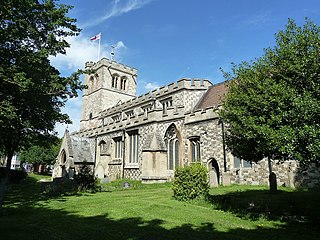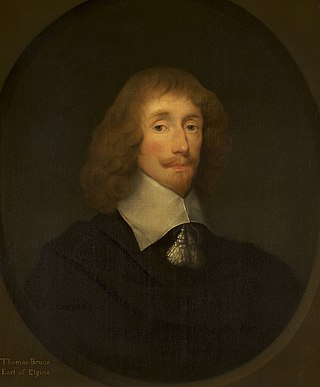
John William Burgon was an English Anglican divine who became the Dean of Chichester Cathedral in 1876. He was known during his lifetime for his poetry and his defense of the historicity and Mosaic authorship of Genesis. Long after his death he was remembered chiefly for his defense of the Byzantine text-type.

Houghton House is a ruined mansion house in the parish of Houghton Conquest, Bedfordshire. It is a Grade I listed building, positioned above the surrounding countryside, and commands excellent views. Built from 1615 to 1621, it is said that the house was the model for House Beautiful in John Bunyan's The Pilgrim's Progress (1678). It was abandoned in 1794 and stripped of its interiors and roof for sale as building supplies. Today the property is owned by English Heritage, and is open to free public access during daylight hours.

Saint Anne's Church serves in the Church of England the Soho section of London. It was consecrated on 21 March 1686 by Bishop Henry Compton as the parish church of the new civil and ecclesiastical parish of St Anne, created from part of the parish of St Martin in the Fields. The church is under the Deanery of Westminster in the Diocese of London.

All Saints' Church, Bakewell, is the parish church of Bakewell, Derbyshire, England. It is a Grade I listed building.

The King's Wardrobe, together with the Chamber, made up the personal part of medieval English government known as the King's household. Originally the room where the king's clothes, armour, and treasure were stored, the term was expanded to describe both its contents and the department of clerks who ran it. Early in the reign of Henry III the Wardrobe emerged out of the fragmentation of the Curia Regis to become the chief administrative and accounting department of the Household. The Wardrobe received regular block grants from the Exchequer for much of its history; in addition, however, the wardrobe treasure of gold and jewels enabled the king to make secret and rapid payments to fund his diplomatic and military operations, and for a time, in the 13th-14th centuries, it eclipsed the Exchequer as the chief spending department of central government.
The Archdeacon of Lothian was the head of the Archdeaconry of Lothian, a sub-division of the Diocese of St Andrews. The position was one of the most important positions within the medieval Scottish church; because of his area's large population and high number of parish churches, the Archdeacon of Lothian may have exercised more power than many Scottish bishops before the decline in archdiaconal powers after the 13th century.

St Botolph-without-Bishopsgate is a Church of England church in the Bishopsgate Without area of the City of London, and also, by virtue of lying outside the city's eastern walls, part of London's East End.

Houghton Conquest is a village and civil parish located in the Central Bedfordshire district of Bedfordshire, England. The parish also includes the hamlet of How End.
Edward Martin, D.D. was an English clergyman, ejected President of Queens' College, Cambridge, and at the end of his life Dean of Ely.
This is a list of Sheriffs of Bedfordshire and Buckinghamshire. One sheriff was appointed for both counties from 1125 until the end of 1575, after which separate sheriffs were appointed. See High Sheriff of Bedfordshire and High Sheriff of Buckinghamshire for dates before 1125 or after 1575.
Thomas Archer (1554-1630?) was an English divine.
Henry John Rose was an English churchman, theologian of High Church views, and scholar who became archdeacon of Bedford.
Benedict Nichols, also spelt Nicholls, was a priest and bishop of the Roman Catholic Church, successively a parish priest in England, a canon of Salisbury Cathedral, and Bishop of Bangor and Bishop of St David's in Wales.

St Mary's Church, Higham Ferrers is a Church of England parish church in Higham Ferrers, Northamptonshire. It is a Grade I listed building.

Edmund Wylde or Edmund Wilde FRS was an English politician who sat in the House of Commons from 1646 to 1653.

The Church of All Saints, formerly The Church of St. Michael, is a medieval building and an active Anglican parish church in Houghton Regis in the English county of Bedfordshire. It is a 13th century Grade I listed building.
James Smith was a clergyman who became Archdeacon of Barnstaple in 1660. He was also much admired for his wit, and collections of his satirical verse were published in the 1650s.

Thomas Bruce, 1st Earl of Elgin, 3rd Lord Bruce of Kinloss, of Houghton House in the parish of Maulden in Bedfordshire, was a Scottish nobleman.

St John the Baptist's Church, Collingham is a Grade I listed parish church of the Church of England in the village of Collingham, Nottinghamshire.
Charles Longuet Higgins (1806–1885) was an English landowner, physician and benefactor.












